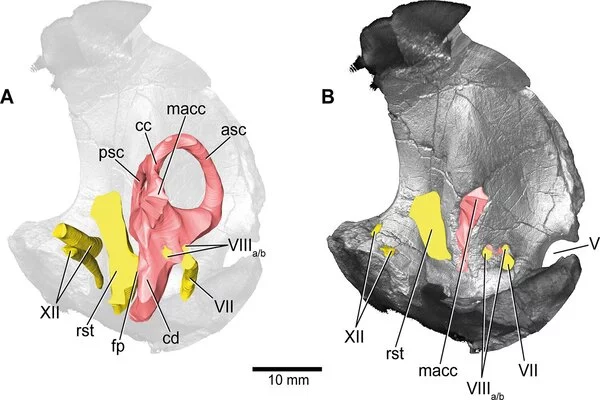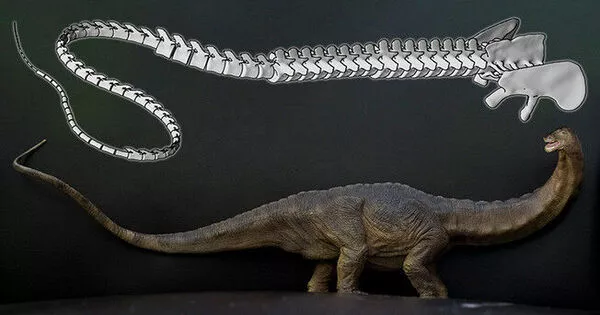Europasaurus was a small, herbivorous dinosaur that lived in what is now Europe during the Late Jurassic period, about 150 million years ago. It is known for its small size, with adults reaching only about 4 meters (13 feet) in length, and its long neck and tail.
The inner ear of Europasaurus, as well as other dinosaurs, can provide clues about its behavior and lifestyle. The inner ear is responsible for balance and hearing, and the structure of the inner ear can vary depending on the type of animal and its preferred mode of movement.
In Europasaurus, the inner ear is relatively small and simple, indicating that it was not an agile or active animal. This is consistent with its small size and herbivorous diet, as well as the fact that it lived in a relatively warm and humid environment. It is likely that Europasaurus spent much of its time grazing on plants, rather than running or climbing.
Overall, the inner ear of Europasaurus provides insight into the life and behavior of this small dinosaur, and helps us to better understand the diversity of dinosaurs that lived during the Late Jurassic period.
Europasaurus was a long-necked, herbivorous dinosaur that lived 154 million years ago on a small island in modern-day Germany during the Late Jurassic period. Recently, scientists from the universities of Vienna and Greifswald used micro-computed tomography to examine Europasaurus fossil braincase material (micro-CT). The digital reconstruction of Europasaurus’ inner ear provided researchers with new insights not only into its hearing ability, but also into its reproductive and social behavior. The study was recently published in the journal eLife.
This implies that very young Europasaurus individuals relied heavily on their ability to equilibrate. Some thought the skull remains were so small (~2 cm) that they could have belonged to hatchlings, making the species precocial.
Sebastian Stumpf
Europasaurus, like its famous relative Brachiosaurus, is a member of the sauropod dinosaur family, which includes the world’s largest land-living animals. Some representatives could reach body lengths of 40 meters and weigh up to 80 metric tons. Europasaurus holgeri, on the other hand, was a small sauropod with a body height of up to three metres.
Europasaurus, which lived on an island in modern-day Germany about 154 million years ago, was the first dinosaur to exhibit the evolutionary phenomenon of insular dwarfism, which occurs when large island-dwelling animals become smaller over a number of generations. Europasaurus may be the fossil counterpart to the recent Sumatran tiger and rhino, which are smaller than their mainland relatives.

Fossil skull remains of very young to fully-grown adults have been examined
Scientists from the universities of Greifswald and Vienna examined fossil braincase material from Europasaurus ranging in age from very young and small individuals to adults for the recently published study. The researchers used micro-CT to reconstruct the cavities that once housed the brain and inner ears in order to learn more about these long-extinct animals.
The lagena or cochlea, the part of the inner ear that is responsible for hearing, appears to be relatively long in Europasaurus. This indicates that these animals had a good sense of hearing, making intraspecific communication and gregarious behavior possible.
Europasaurus was probably precocial
Another part of the inner ear that is important for balance consists of three tiny arches. The scientists discovered that the inner ear cavities of very small specimens resemble the cavities of adults in shape and size.
“This implies that very young Europasaurus individuals relied heavily on their ability to equilibrate. Some thought the skull remains were so small (~2 cm) that they could have belonged to hatchlings, making the species precocial” Sebastian Stumpf of the University of Vienna agrees. Whereas some sauropods weighed several tens of tons more than their newly hatched offspring (posing a lethal threat to the latter), Europasaurus hatchlings may have followed the herd in some fashion.
















